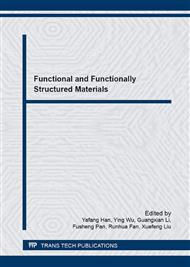[1]
K. Lu, J. Lu, Nanostructured surface layer on metallic materials induced by surface mechanical attrition treatment, Mater. Sci. Eng. A. 38 (2004) 375-377.
DOI: 10.1016/j.msea.2003.10.261
Google Scholar
[2]
S.C. Tjong, H. Chen, Nanocrystalline materials and coatings, Mater. Sci. Eng. R. 1 (2004) 45.
Google Scholar
[3]
T. H. Fang, W. L. Li, N. R. Tao, K. Lu, Revealing extraordinary intrinsic tensile plasticity in gradient nano-grained copper, Science. 331 (2011) 1587-1590.
DOI: 10.1126/science.1200177
Google Scholar
[4]
Y.J. Wei, Y.Q. Li, L.C. Zhu, Y. Liu, X.Q. Lei, G. Wang, Y.X. Wu, Z.L. Mi, J.B. Liu, H.T. Wang, H.J. Gao, Evading the strength-ductility trade-off dilemma in steel through gradient hierarchical nanotwins, Nat. Commun. 5 (2014) 3580.
DOI: 10.1038/ncomms4580
Google Scholar
[5]
X. Wu, P. Jiang, L. Chen, F. Yuan, Y. T. Zhu, Extraordinary strain hardening by gradient structure, Proc. Natl. Acad. Sci. U.S.A. 111(2014) 7197-7201.
DOI: 10.1073/pnas.1324069111
Google Scholar
[6]
J.P. Hirth, J. Lothe. Theory of Dislocations, 2 Ed., John Wiley & Son Inc., Canada, (1982).
Google Scholar
[7]
Y.H. Zhao, Z. Horita, T.G. Langdon, Y.T. Zhu, Evolution of defect structures during cold rolling of ultrafine-grained Cu and Cu-Zn alloys: Influence of stacking fault energy, Mater. Sci. Eng. A. 474 (2008) 342-347.
DOI: 10.1016/j.msea.2007.06.014
Google Scholar
[8]
L. Balogh, T. Ungár, Y. Zhao, Y.T. Zhu, Z. Horita, C. Xu, T.G. Langdon, Influence of stacking-fault energy on microstructural characteristics of ultrafine-grain copper and copper–zinc alloys, Acta. Mater. 56 (2008) 809-820.
DOI: 10.1016/j.actamat.2007.10.053
Google Scholar
[9]
S. Qu, X.H. An, H.J. Yang, C.X. Huang, G. Yang, Q.S. Zang, Z.G. Wang, S.D. Wu, Z.F. Zhang, Microstructural evolution and mechanical properties of Cu-Al alloys subjected to equal channel angular pressing, Acta. Mater. 57 (2009) 1586-1601.
DOI: 10.1016/j.actamat.2008.12.002
Google Scholar
[10]
B. Bay, N. Hansen, D.A. Hughes, D. Kuhlmann-Wilsdorf, Overview no. 96 evolution of f. c. c. deformation structures in polyslip, Acta Metall. Mater. 40 (1992) 205-219.
DOI: 10.1016/0956-7151(92)90296-q
Google Scholar
[11]
Y.H. Zhao, Y.T. Zhu, X.Z. Liao, Z. Horita, T.G. Langdon, Tailoring stacking fault energy for high ductility and high strength in ultrafine grained Cu and its alloy, Appl. Phys. Lett. 89 (2006) 121906.
DOI: 10.1063/1.2356310
Google Scholar
[12]
Z.J. Zhang, Q.Q. Duan, X.H. An, S.D. Wu, G. Yang, Z.F. Zhang, Microstructure and mechanical properties of Cu and Cu-Zn alloys produced by equal channel angular pressing, Mater. Sci. Eng. A. 528(2011) 4259-4267.
DOI: 10.1016/j.msea.2010.12.080
Google Scholar
[13]
H. Bahmanpour, A. Kauffmann, M.S. Khoshkhoo, K.M. Youssef, S. Mula, J. Freudenberger, J. Eckert, R.O. Scattergood, C.C. Koch, Effect of stacking fault energy on deformation behavior of cryo-rolled copper and copper alloys, Mater. Sci. Eng. A. 529 (2011).
DOI: 10.1016/j.msea.2011.09.022
Google Scholar
[14]
Z.S. You, L. Lu, K. Lu, Temperature effect on rolling behavior of nano-twinned copper, Scripta Mater. 62 (2010) 415-418.
DOI: 10.1016/j.scriptamat.2009.12.002
Google Scholar
[15]
Y. Zhang, N.R. Tao, K. Lu, Mechanical properties and rolling behaviors of nano-grained copper with embedded nano-twin bundles, Acta. Mater, 56 (2008) 2429-2440.
DOI: 10.1016/j.actamat.2008.01.030
Google Scholar
[16]
Y. Wang, E. Ma, R. Z. Valiev, Y. T Zhu, Tough nanostructured metals at cryogenic temperatures, Adv. Mater. 16(2004) 328-331.
DOI: 10.1002/adma.200305679
Google Scholar
[17]
X.H. An, W.Z. Han, C.X. Huang, P. Zhang, G. Yang, S.D. Wu, Z.F. Zhang, High strength and utilizable ductility of bulk ultrafine-grained Cu-Al alloys, Appl. Phys. Lett. 92(2008) 201915.
DOI: 10.1063/1.2936306
Google Scholar
[18]
K. Lu, J. Lu, Surface nanocrystallization (SNC) of metallic materials: presentation of the concept behind a new approach, J. Mater. Sci. Technol. 15 (1999) 193-197.
Google Scholar
[19]
T. Ungár, S. Ott, P.G. Sanders, A. Borbély, J.R. Weertman, Dislocations, grain size and planar faults in nanostructured copper determined by high resolution X-ray diffraction and a new procedure of peak profile analysis, Acta Mater. 46 (1998).
DOI: 10.1016/s1359-6454(98)00001-9
Google Scholar
[20]
C.N.J. Wagner, Stacking faults by low-temperature cold work in copper and alpha brass, Acta Metall. 5 (1957) 427-434.
DOI: 10.1016/0001-6160(57)90060-3
Google Scholar
[21]
J.B. Cohen, C.N.J. Wagner, Determination of twin fault probabilities from the diffraction patterns of fcc metals and alloys, J. Appl. Phys. 33 (1962) (2073).
DOI: 10.1063/1.1728897
Google Scholar
[22]
T. Ungar, Microstructural parameters from X-ray diffraction peak broadening, Scripta Mater. 51 (2004) 777-781.
DOI: 10.1016/j.scriptamat.2004.05.007
Google Scholar
[23]
M.A. Meyers, K.K. Chawla, Mechanical Metallurgy-Principles and Applications, Prentice Hall, Englewood Cliffs, NJ, (1984).
Google Scholar
[24]
J. Gubicza, N.Q. Chinh, J.L. Lábár, Z. Hegedus, T.G. Langdon, Principles of self-annealing in silver processed by equal-channel angular pressing: The significance of a very low stacking fault energy, Mater. Sci. Eng. A. 527 (2010) 752-760.
DOI: 10.1016/j.msea.2009.08.071
Google Scholar
[25]
Y.H. Zhao, J.F. Bingert, X.Z. Liao, B.Z. Cui, K. Han, A.V. Sergueeva, A.K. Mukherjee, R.Z. Valiev, T.G. Langdon, Y.T. Zhu, Simultaneously increasing the ductility and strength of Ultra-Fine-Grained pure copper, Adv. Mater. 18 (2006) 2949-2953.
DOI: 10.1002/adma.200601472
Google Scholar
[26]
P.L. Sun, Y.H. Zhao, J.C. Cooley, M.E. Kassner, Z. Horita, T.G. Langdon, E.J. Lavernia, Y.T. Zhu, Effect of stacking fault energy on strength and ductility of nanostructured alloys: An evaluation with minimum solution hardening, Mater. Sci. Eng. A. 525 (2009).
DOI: 10.1016/j.msea.2009.06.030
Google Scholar
[27]
C. Zener, J.H. Hollomon, Effect of strain-rate on plastic flow of steel, J. Appl. Phys. 15 (1944) 22-32.
DOI: 10.1063/1.1707363
Google Scholar


